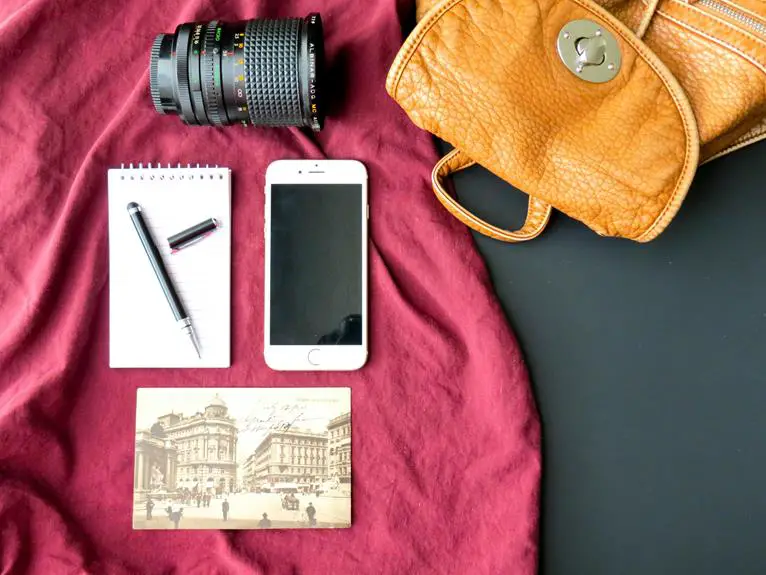You might be surprised to learn how rapidly technology is evolving to tackle the age-old problem of fabric creasing. With innovations like smart textiles and advanced materials, the way we care for our clothes could soon be transformed. Imagine garments that not only resist wrinkles but also adapt to your environment. As these technologies develop, they raise important questions about convenience, sustainability, and consumer preferences. What might the future hold for our daily routines, and how will these advancements change the way we think about fabric care?
Table of Contents
Key Takeaways
- Advances in wrinkle-resistant fabrics and shape-memory polymers significantly reduce the need for ironing by maintaining original shape after creasing.
- Nanotechnology enhances fabric properties, providing superior wrinkle resistance and self-cleaning capabilities, which minimize maintenance requirements.
- Smart textiles with adaptive materials adjust to environmental changes, maintaining crispness and reducing the occurrence of wrinkles.
- Energy-efficient ironing alternatives, like handheld steamers and cold ironing technology, conserve energy while effectively removing creases.
Advances in Material Science
Recent breakthroughs in material science are revolutionizing how fabrics respond to creasing, making them more resilient and easier to maintain.
You'll find that innovative techniques like nano-coating and polymer blending are transforming everyday textiles. These advancements not only help minimize creasing but also enhance the overall performance of fabrics.
For instance, fabrics infused with special polymers can stretch and recover their shape after being wrinkled. This means you won't have to deal with the hassle of constant ironing.
Additionally, researchers are developing textiles that incorporate mechanical properties allowing them to resist deformation, providing a longer-lasting, crisp appearance.
You might also encounter fabrics treated with heat-resistant finishes, which allow them to withstand the rigors of everyday wear while maintaining a smooth look. These treatments can be applied to a variety of materials, from cotton to synthetic blends, ensuring that you have options no matter your style preference.
As these technologies continue to evolve, you can expect even greater improvements in fabric performance, making your wardrobe easier to care for and more stylish.
Embracing these advances in material science will undoubtedly simplify your life while keeping you looking sharp.
Smart Textiles and Wearable Tech
Smart textiles and wearable tech are changing how you think about fabric and fashion.
With innovative fabric technologies, you can now enjoy garments that respond to your environment and needs.
As you explore future trends, you'll see just how much potential these advancements hold for everyday life.
Innovative Fabric Technologies
Innovative fabric technologies are transforming the way you interact with textiles, blending functionality and style in everyday wear. These advancements not only enhance comfort but also address practical challenges like fabric creasing. Here are some cutting-edge innovations you should know about:
- Wrinkle-Resistant Fabrics: These materials are engineered to resist creasing, allowing you to look sharp all day without constant ironing.
- Moisture-Wicking Textiles: Fabrics that draw moisture away from your skin help maintain a fresh feel, reducing the chances of wrinkles forming due to dampness.
- Shape-Memory Polymers: These smart materials can return to their original shape after being stretched or creased, ensuring that garments maintain their intended silhouette.
- Nano-coatings: Applying nano-coatings to fabrics can create a protective layer, repelling dirt and stains, which reduces the need for frequent washing that can cause wear and creasing.
With these innovative fabric technologies, you're not just investing in clothing; you're selecting pieces that enhance your lifestyle while tackling common issues like creasing, ensuring you always look your best.
Wearable Tech Applications
Wearable tech is revolutionizing how you experience clothing, blending functionality with your everyday attire to create garments that adapt to your lifestyle. Smart textiles incorporate advanced materials that can repel water, resist stains, or even self-clean, ensuring you look fresh and polished throughout your day. Imagine wearing a shirt that can sense moisture and release heat, keeping you comfortable in changing environments.
With wearable tech, you can also track your movements and monitor your health right from your clothing. Some garments come embedded with sensors that provide real-time feedback on your body's performance, allowing you to optimize your activities. This technology can help reduce the need for frequent washing, which often leads to fabric creasing.
Moreover, smart fabrics can respond to your needs. For instance, a jacket might adjust its insulation based on the weather, ensuring you're always at the right temperature without the bulk of extra layers.
As you embrace this innovative technology, you're not just investing in clothes; you're investing in a lifestyle that prioritizes convenience and adaptability. Wearable tech is paving the way for a future where your wardrobe works as hard as you do.
Future Trends Forecast
The integration of advanced technology into textiles is set to redefine how you interact with your clothing, making everyday wear more functional and responsive to your needs. As smart textiles and wearable tech evolve, you'll experience a significant reduction in fabric creasing, enhancing both comfort and style.
Here are four trends to watch:
- Self-Cleaning Fabrics: Imagine clothes that repel dirt and stains, reducing the need for frequent washing and minimizing creases in the process.
- Adaptive Materials: Fabrics that adjust their properties based on temperature or humidity will help maintain a crisp appearance no matter the weather.
- Integrated Sensors: Wearable tech can monitor your movements and adjust the fabric tension, ensuring your clothing always looks sharp and wrinkle-free.
- Energy Harvesting Textiles: Clothes that generate power from your movements can power small devices, combining utility with style while cutting down on maintenance.
These innovations won't only change how you wear clothes but also how you perceive their role in your daily life, making them smarter and more versatile than ever before.
Innovations in Fabric Treatments
Numerous advancements in fabric treatments are transforming how we care for and maintain our clothing. You'll find that new techniques are making fabrics more resilient and less prone to creasing. For instance, innovative finishes and coatings are now available that enhance a fabric's natural properties. These treatments might include moisture-wicking abilities or stain resistance, adding layers of protection while keeping your garments looking fresh.
Moreover, you can take advantage of wrinkle-resistant fabrics that have been engineered to retain their shape. Many brands are incorporating these treatments into their clothing lines, which means you'll spend less time ironing and more time enjoying your outfits.
You might also notice that natural fibers are being treated with eco-friendly solutions, creating sustainable options that don't sacrifice performance. These innovations are designed to cater to your lifestyle, allowing you to feel good about your choices while keeping your wardrobe looking sharp.
Ultimately, these advancements in fabric treatments aren't only convenient but also contribute to the longevity of your clothes. Embracing these innovations means you can enjoy a more hassle-free approach to maintaining your wardrobe.
The Role of Nanotechnology
Advancements in fabric treatments set the stage for nanotechnology to revolutionize how we tackle fabric creasing and enhance performance. By manipulating materials at the molecular level, you can significantly improve the resilience and appearance of textiles.
Here are four key ways nanotechnology is transforming the fabric industry:
- Self-Cleaning Properties: Nanoparticles can create surfaces that repel dirt and stains, making it easier for you to maintain your garments without frequent washing.
- Enhanced Durability: Incorporating nanofibers into fabrics increases their strength and resistance to wear and tear, prolonging the life of your clothing.
- Wrinkle Resistance: Nanotechnology can modify the structure of fibers, giving them the ability to resist creasing even after prolonged use, which means less ironing for you.
- Breathability and Comfort: Innovative nanomaterials can improve airflow and moisture-wicking properties, keeping you comfortable while minimizing fabric creasing.
Eco-Friendly Solutions for Fabrics
As you explore eco-friendly solutions for fabrics, you'll find innovative options that prioritize sustainability.
Consider how biodegradable anti-crease treatments can reduce environmental impact and how energy-efficient ironing alternatives can save resources.
These advancements not only help the planet but also enhance your fabric care routine.
Sustainable Fabric Innovations
Sustainable fabric innovations are transforming the textile industry by introducing eco-friendly solutions that minimize environmental impact while enhancing performance. As you explore these advancements, you'll find that many brands are now prioritizing sustainability in their production processes.
Here are four key innovations making waves in the market:
- Recycled Materials: Fabrics made from recycled plastics or old garments reduce waste and resource consumption while providing durable, high-quality textiles.
- Organic Fibers: Utilizing organic cotton, hemp, and bamboo helps to eliminate harmful pesticides and chemicals, promoting healthier ecosystems.
- Waterless Dyeing Techniques: These innovative methods significantly reduce water usage and pollution, ensuring that the dyeing process has a lower environmental footprint.
- Natural Finishes: Using plant-based finishes and treatments can enhance fabric performance without introducing harmful synthetic chemicals, ensuring both safety and sustainability.
Biodegradable Anti-Crease Treatments
Building on the momentum of sustainable fabric innovations, biodegradable anti-crease treatments offer an eco-friendly solution to keep your garments looking fresh without harming the environment. These treatments use natural substances that break down safely after use, ensuring they don't contribute to pollution or waste.
When you apply these biodegradable options, you're not just reducing wrinkles; you're also making a conscious choice for the planet. Many of these treatments are derived from plant-based materials, making them effective yet gentle on your clothes. They work by forming a protective barrier that resists creasing while allowing the fabric to breathe.
You'll find that using biodegradable treatments can extend the life of your garments, as they often include conditioning agents that help maintain fabric integrity. This means fewer trips to the dry cleaner, saving you money and reducing your carbon footprint.
As you embrace these innovative solutions, you're contributing to a more sustainable future. With biodegradable anti-crease treatments, you're making your wardrobe more resilient and eco-friendly, aligning your fashion choices with your values.
Energy-Efficient Ironing Alternatives
In today's world, energy-efficient ironing alternatives are transforming how you keep your fabrics wrinkle-free while minimizing environmental impact. By embracing innovative solutions, you can save energy and reduce your carbon footprint without sacrificing the quality of your garments.
Consider these four eco-friendly options:
- Steamers: Handheld steamers use less energy than traditional irons and are effective at removing wrinkles. They heat up quickly and can be used on various fabrics.
- Wrinkle-Resistant Fabrics: Investing in wrinkle-resistant clothing means less ironing overall. These fabrics are designed to maintain their shape and smoothness, saving you time and energy.
- Cold Ironing Technology: Some modern irons feature cold ironing technology, which uses a combination of steam and pressure to eliminate creases without the need for high heat, conserving energy.
- Ironing Mats with Insulation: Use heat-reflective ironing mats that conserve heat and reduce energy consumption. They work by reflecting heat back into the fabric, requiring less energy to smooth out wrinkles.
Adopting these energy-efficient alternatives not only keeps your clothes looking sharp but also contributes to a more sustainable future.
Consumer Trends and Preferences
Today's consumers increasingly prefer smart fabric creasing solutions that combine convenience with efficiency. You want products that not only save time but also deliver high-quality results. Traditional ironing methods can be tedious, and you're looking for alternatives that fit seamlessly into your busy lifestyle.
As a result, you're drawn to innovations like steamers, wrinkle-resistant fabrics, and even high-tech ironing machines that offer automated features. These solutions allow you to quickly refresh clothes without the hassle of setting up an ironing board or waiting for an iron to heat up.
Moreover, sustainability plays a significant role in your preferences. Many consumers are opting for energy-efficient devices that lessen their environmental impact while still providing excellent performance. You appreciate brands that prioritize eco-friendly materials and practices, aligning with your values.
You also value versatility in these solutions, seeking products that can handle various fabric types with ease. Hence, you're more inclined to invest in smart technologies that adapt to your needs, ensuring your garments look impeccable with minimal effort.
Ultimately, the trend is clear: convenience, efficiency, and sustainability are top priorities for modern consumers like you.
Future Predictions and Possibilities
As technology continues to evolve, you can expect fabric creasing solutions to become even smarter, integrating AI and machine learning to personalize your garment care experience. Imagine a world where your clothes are treated with precision, reducing creases while extending their lifespan. This isn't just a dream; it's on the horizon.
Here are some possibilities you might see:
- Smart Washing Machines: Future machines will assess fabric types and automatically adjust wash cycles, ensuring minimal creasing through optimized settings.
- AI-Powered Irons: Picture irons that learn your ironing habits, adjusting heat settings and steam levels based on the fabric's needs to eliminate wrinkles more effectively.
- Wearable Tech: Imagine clothing embedded with sensors that detect creases in real-time and release heat or steam to smooth them out automatically.
- Fabric Treatments: Innovative coatings might be developed that repel wrinkles, making your garments crease-resistant right from the start.
With these advancements, you'll find that managing fabric creasing becomes easier, allowing you to focus on what truly matters—your style and comfort.
Frequently Asked Questions
How Do Fabric Creases Affect Clothing Longevity and Appearance?
Fabric creases can significantly impact your clothing's longevity and appearance. They weaken fibers over time, leading to premature wear. Plus, visible creases create an unkempt look, affecting your overall style and confidence when you wear them.
What Are the Most Common Causes of Fabric Creasing?
Fabric creasing often happens due to improper storage, folding, or washing. When you leave clothes crammed in drawers, or neglect to hang them, you increase the chances of those annoying wrinkles forming.
Can Traditional Ironing Methods Still Be Effective With New Technologies?
You can still find traditional ironing methods effective when combined with new technologies. While steam generators and smart irons enhance results, classic techniques remain reliable for achieving smooth, wrinkle-free fabrics in your daily routine.
How Do Consumer Preferences Influence Fabric Design Against Creasing?
Consumer preferences shape fabric design by prioritizing comfort and low-maintenance options. You'll find designers experimenting with blends and weaves that resist creasing, catering to your desire for easy-care, versatile clothing that fits your lifestyle.
Are There Specific Fabrics That Naturally Resist Creasing Better Than Others?
Yes, some fabrics naturally resist creasing better than others. Polyester, nylon, and blends with spandex tend to hold their shape well. When choosing, look for these materials if you want a more wrinkle-resistant option.
- How Does Ring Spun Cotton Affect Garment Fit and Shape Retention? - August 13, 2024
- What Are the Challenges in Producing Ring Spun Cotton? - August 13, 2024
- Is Ring Spun Cotton Suitable for Plus-Size Clothing? - August 13, 2024





